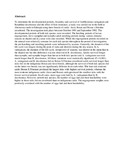Development, reproductive capacity and survival of Amblyomma variegatum and Boophilus decoloratus in relation to host resistance and climatic factors under field conditions

View/
Date
1998-02Author
Solomon G.
Kaaya Godwin P.
Type
ArticleLanguage
enMetadata
Show full item recordAbstract
To determine the developmental periods, fecundity and survival of Amblyomma variegatum and Boophilus decoloratus and the effect of host resistance, a study was carried out in the field at Abernossa ranch in Ethiopia using three breeds of cattle: Arssi, Boran and Boran x Friesian crossbreed. The investigation took place between October 1991 and September 1992. The developmental periods of both tick species were recorded. The hatching periods of larvae, engorgement, larvo-nymphal and nympho-adult moulting periods during various climatic seasons in shaded and dry areas were also recorded. While the engorgement periods recorded on the animal were relatively constant for each tick species throughout the period of investigation, the pre-hatching and moulting periods were influenced by seasons. Generally, the duration of the life cycle was longest during the peak of rains and shortest during the dry season. In A. variegatum, the duration of the life cycle, irrespective of seasons, was shorter in the open than in the shaded site but this difference was not observed in B. decoloratus. Adults survived longer than nymphs, and nymphs longer than larvae in both tick species and A. variegatum survived much longer than B. decoloratus. All these variations were statistically significant (P < 0.001). A. variegatum and B. decoloratus fed on Boran X Friesian crossbreed cattle survived longer than ticks fed on the indigenous Boran and Arssi breeds, although the survival of both tick species fed on the latter two breeds was not significantly different from each other. The least tick resistant cattle (Boran X Friesian) produced the largest ticks with highest survival periods, whereas the most resistant indigenous cattle (Arssi and Boran) cattle produced the smallest ticks with the lowest survival periods. In all cases, more eggs were laid by A. variegatum than by B. decoloratus. However, in both tick species, the number of eggs laid and their hatchability were higher in those ticks fed on crossbreed than on indigenous cattle. The engorgement weights were positively correlated with the number of eggs laid and their hatchability.
URI
http://www.ncbi.nlm.nih.gov/pubmed/9637226http://erepository.uonbi.ac.ke:8080/xmlui/handle/123456789/35229
Citation
Vet Parasitol. 1998 Feb 28;75(2-3):241-53.Publisher
University of Nairobi. School of Biological Sciences
